Harvard Stadium
Introduction
Text-to-speech Audio
Harvard Stadium opened on November 14, 1903 as the first collegiate athletic stadium in the United States. The nation's oldest stadium is located in the Allston neighborhood of Boston, Massachusetts. With Greek and Roman influences, the U-shaped stadium is also the world's first massive reinforced concrete structure used solely for collegiate sports. Harvard Stadium could accommodate as many as 57,166 spectators in the steel stands located in the north end zone until the stands were removed in 1951. Currently, the stadium has a capacity of 30,323. Rich in sport history, Harvard Stadium is one of four athletic arenas recognized as a National Historic Landmark.
Images
Harvard Stadium is the always sold-out site of the historic Harvard-Yale football game, simply titled "The Game" for its national importance.
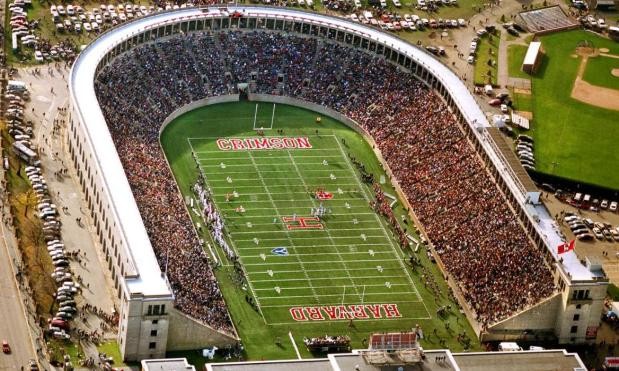
Harvard Stadium Field View
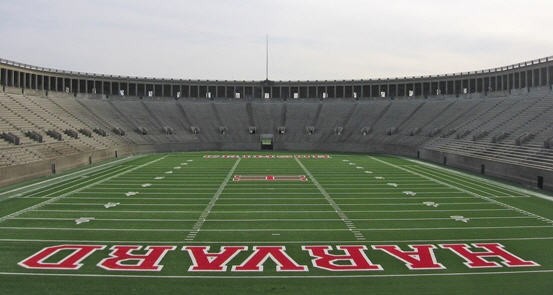
Harvard Stadium
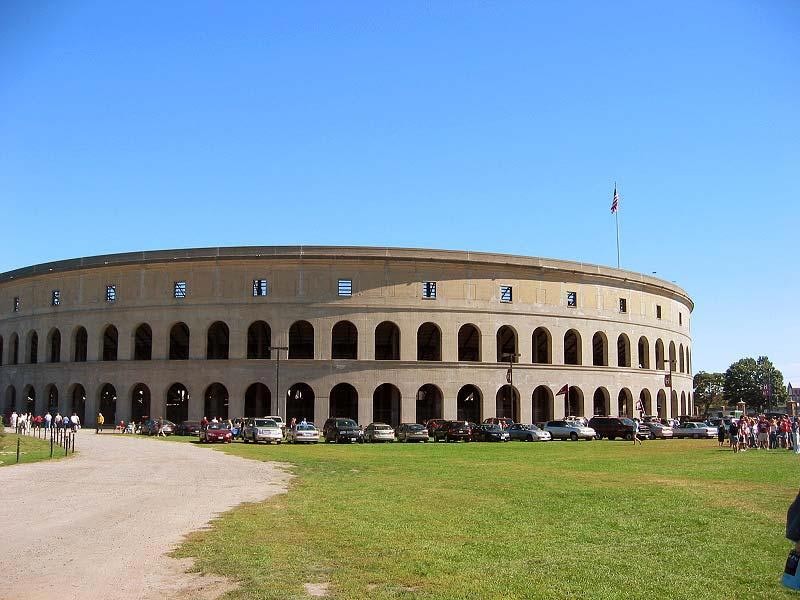
Harvard Stadium
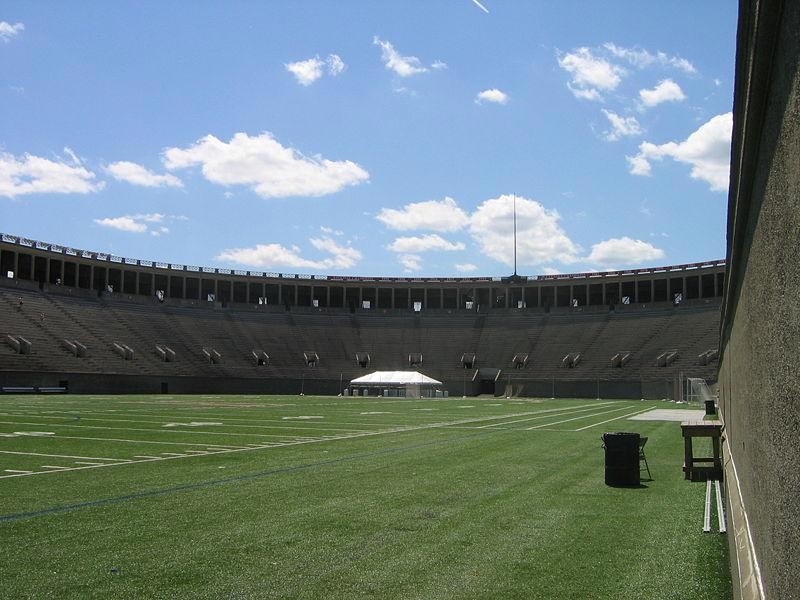
Harvard Stadium
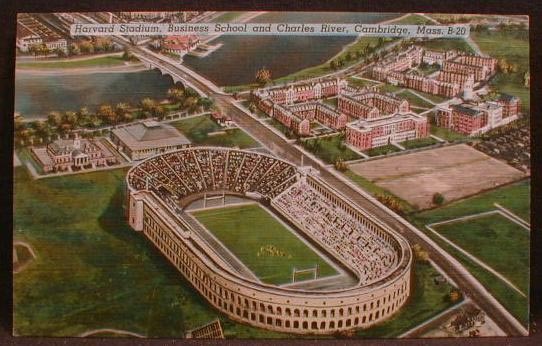
Backstory and Context
Text-to-speech Audio
Harvard University played home football games in several locations until the creation of the historic stadium in 1903 on 31 acres of land known as Soldiers Field donated to the University by Henry Lee Higginson.1 Constructed in less than five months, the stadium was a 25th anniversary gift of the Class of 1879 that cost approximately $310,000.2 However, the field has served more purposes than just for the famous Harvard-Yale rivalry football game. The stadium is home to track and field, rugby, lacrosse, soccer, professional football and ice hockey.3 The American Football League Boston Patriots called the Harvard Stadium home for two years in 1970.4 The Stadium has also hosted the U.S. track and field Olympic trials in 1916 and 1920 as well as an Olympic soccer competition in the summer of 1984.5 Recently, the stadium has become home to the Boston Breakers of the Women's Professional Soccer league.6
Aside from being an engineering marvel, Harvard Stadium helped change the game of football. In 1905, President Charles W. Eliot threatened to get rid of the rough game that football had become.7 Fearful of injury and potential long term damage, football was almost removed from Harvard University just two years after completing the new stadium.8 The National Collegiate Athletic Association decided to implement new rules promoting player safety, forbiddance of tackling out of bounds, face mask tackles, and tackling below the knee as a way to salvage the game.9 Another measure to ensure player safety was to increase the width of the playing field.10 However, due to the permanent nature of the newly built Harvard Stadium, it was not possible to increase the width of the field. As an alternative measure, "the committee agreed to ratify the novel and somewhat controversial forward pass, changing the sport forever."11 Fortunately Eliot got what he was after and Harvard Stadium continues to serve as one of the most recognized football stadiums. "In hindsight, however, it was the adoption of the forward pass curtailed the sport's violence and led to the surge in popularity that remains to this day."12
Since its grand opening, Harvard Stadium has hosted over 635 football games for an all-time stadium record remaining as one of the greatest venues in organized football.13 Over the years the stadium has made improvements including the removable dome-like "bubble" used during the end of football season.14 The "bubble" covers the playing field from November until the spring allowing the space to be utilized during the cold winter months.15
Aside from being an engineering marvel, Harvard Stadium helped change the game of football. In 1905, President Charles W. Eliot threatened to get rid of the rough game that football had become.7 Fearful of injury and potential long term damage, football was almost removed from Harvard University just two years after completing the new stadium.8 The National Collegiate Athletic Association decided to implement new rules promoting player safety, forbiddance of tackling out of bounds, face mask tackles, and tackling below the knee as a way to salvage the game.9 Another measure to ensure player safety was to increase the width of the playing field.10 However, due to the permanent nature of the newly built Harvard Stadium, it was not possible to increase the width of the field. As an alternative measure, "the committee agreed to ratify the novel and somewhat controversial forward pass, changing the sport forever."11 Fortunately Eliot got what he was after and Harvard Stadium continues to serve as one of the most recognized football stadiums. "In hindsight, however, it was the adoption of the forward pass curtailed the sport's violence and led to the surge in popularity that remains to this day."12
Since its grand opening, Harvard Stadium has hosted over 635 football games for an all-time stadium record remaining as one of the greatest venues in organized football.13 Over the years the stadium has made improvements including the removable dome-like "bubble" used during the end of football season.14 The "bubble" covers the playing field from November until the spring allowing the space to be utilized during the cold winter months.15
Sources
1- "Harvard Stadium Football History." Harvard. N.p., 22 March 2014. Web 30 Mar. 2015. .
2- "Harvard Stadium Football History." Harvard. N.p., 22 March 2014. Web 30 Mar. 2015. .
3- "Harvard Stadium." Harvard . N.p., 22 Mar. 2014. Web. 30 Mar. 2015. .
4- "Harvard Stadium." Harvard . N.p., 22 Mar. 2014. Web. 30 Mar. 2015. .
5- "Harvard Stadium." Harvard . N.p., 22 Mar. 2014. Web. 30 Mar. 2015. .
6- "Harvard Stadium." Harvard . N.p., 22 Mar. 2014. Web. 30 Mar. 2015. .
7- Brooks, Andrew. "Harvard Stadium." Harvard University Gazette. N.p., n.d. Web. 30 Mar. 2015. .
8- Brooks, Andrew. "Harvard Stadium." Harvard University Gazette. N.p., n.d. Web. 30 Mar. 2015. .
9- Brooks, Andrew. "Harvard Stadium." Harvard University Gazette. N.p., n.d. Web. 30 Mar. 2015. .
10- Brooks, Andrew. "Harvard Stadium." Harvard University Gazette. N.p., n.d. Web. 30 Mar. 2015. .
11- Brooks, Andrew. "Harvard Stadium." Harvard University Gazette. N.p., n.d. Web. 30 Mar. 2015. .
12- "Harvard Stadium Football History." Harvard. N.p., 22 March 2014. Web 30 Mar. 2015. .
13- Brooks, Andrew. "Harvard Stadium." Harvard University Gazette. N.p., n.d. Web. 30 Mar. 2015. .
14- "Harvard Stadium Bubble." Harvard University. N.p., 22 March 2014. Web 30 Mar. 2015. .
15- "Harvard Stadium Bubble." Harvard University. N.p., 22 March 2014. Web 30 Mar. 2015. .
